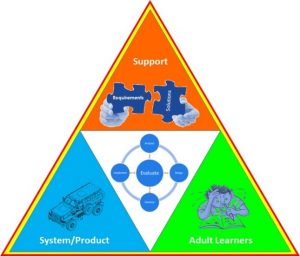DESIGNING SCIENTIFIC ACCOUNTABLE TRAINING PACKAGES AND TECHNICAL MANUALS
Not so long ago technical manuals served as the basis for the design of the training packages without the consideration of educational and instructional design principles. Instructional design is a system of developing well-structured instructional materials using objectives, related teaching strategies, systematic feedback, and evaluation (Moore & Kearsley, 1996). With the advent of instructional design process, (ADDIE process – Analysis, Design, Development, Implementation and Evaluation), as depicted in Figure 1, this approach changed the way course design was performed for the defence environment.
In the early nineties Wally Parsons (Business owner of Walog Training Development) wrote the very first RSA Military Standard, based on the ADDIE process. This standard promoted the scientific course design approach, to develop operator and maintenance training packages for defence systems or products. This standard encapsulates the processes of design and development for scientific and accountable training packages. As depicted in Figure 1, the ADDIE model is superimposed on some of the main logistic drivers.

Figure 1: Typical Support Elements
Applying adult based learning principles on the one side of the continuum and system/ product on the other side of the continuum, driven by support requirements. The support requirements establishes the support elements to enable integration thereof in the logistic support system. The emphasis is on acquiring compliant products with supportability/survivability in the most cost effective way. The purpose of the training development programme, is to ensure, by means of a systematic approach, that the Defence receives an effective training system to train their own personnel. The training programme must be able to convey the necessary knowledge, skills and attitudes, in the most effective way, which in turn will give rise to a safe operating environment. This will also ensure that the product or system is utilized, as designed for, with the necessary support throughout its life cycle.
Personnel and training is one of the most significant support elements in this value chain and plays a pivotal role in the safe operating and support of such systems or product. Hence the reason that we specialize in the scientific development processes of training development with the adult learner in mind.
To ensure that learning has taken place it is essential to allow educational technologist/instructional designers to find and apply the most cost effective solutions in designing training packages.

The instructional designer needs to consider all the adult based learning principles. Learning is not a spectator sport. The more actively engaged the learner is, the more memorable and effective the learning. Adults learn by doing, by trial and error, by observing and reflecting on what goes on in the world around them, through interpersonal relationships with others and by actively trying to make sense of all these experiences. Where exercises, examples and experiences are used to bolster facts and theory, adults learn more and retain more. Adults may be self-directed learners but in some contexts they may prefer or need direction or help from others.
As deducted from this article, Instructional designers are highly talented and motivated people that can develop training that will produce learners who can perform their jobs after receiving instruction, and can accurately identify training requirements and equipment.


